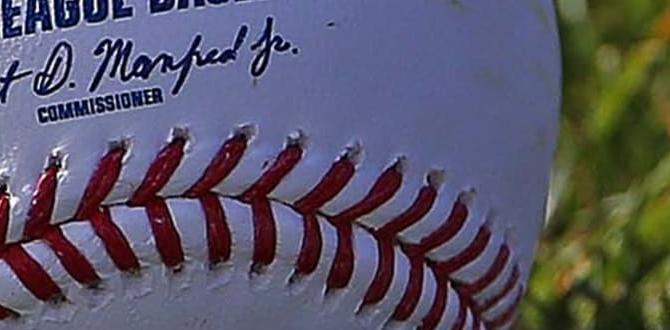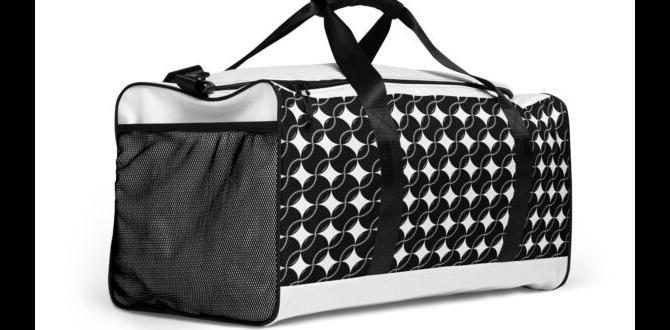Quick Summary: Properly fitting catchers knee savers is crucial for comfort, protection, and peak performance. This guide breaks down how to achieve the perfect fit, ensuring your knee savers stay in place and protect your knees effectively during every play. Get ready to squat with confidence!
Hey there, baseball family! John P. Miller here from FriskMode, and let’s talk about one of the most critical pieces of gear that often gets overlooked: our catcher’s knee savers. If you’ve ever felt your knee savers sliding around, digging in, or just not feeling quite right, you know how distracting and even painful that can be. It’s like trying to focus with a pebble in your shoe – it just pulls you out of the game. But don’t worry, getting that perfect, locked-in fit isn’t a secret handshake reserved for pros. It’s a straightforward process, and by the end of this guide, you’ll know exactly how to make sure your knee savers are your best friend behind the plate, not a nuisance.
Why the Right Fit for Catchers Knee Savers Matters
As a catcher, your knees are constantly taking a beating. Every squat, every block, every foul tip puts pressure on them. That’s where knee savers, often called catcher’s leg guards or shin guards, come in. They’re designed to absorb impact and provide a stable platform. But if they don’t fit right, they can’t do their job effectively. An ill-fitting pair can lead to:
- Discomfort and Pain: Straps that are too tight or guards that are too loose can chafe, pinch, and cause aches.
- Reduced Mobility: When knee savers are constantly shifting, you might subconsciously limit your range of motion to keep them in place, affecting your ability to block and throw.
- Less Protection: If your knee savers aren’t positioned correctly on your leg, they won’t protect the vital areas of your knee during impact.
- Distraction: Constantly adjusting your gear takes your focus away from the game, which is the last thing any catcher needs.
Getting the fit dialed in is key to unlocking their full protective potential and ensuring you can play your best, play comfortably, and play longer. Let’s dive into how to do it.
Understanding Your Catchers Knee Savers
Before we can talk about fitting, it’s good to know what you’re working with. Most modern catcher’s leg guards are designed with a few key components:
- The Shell: This is the hard, protective outer layer. It’s usually made of high-impact plastic designed to deflect balls and absorb shock.
- Padding: Inside the shell, there’s padding (often foam or a combination of materials) that provides cushioning against impacts.
- Straps: These are vital for securing the leg guards. They can be Velcro, buckles, or other clipping mechanisms. Typically, there are multiple straps to ensure a snug fit at different points on your leg.
- Hinges/Flex Points: Some high-end guards have designed flex points to allow for better movement while maintaining protection.
The general idea is that the knee saver should hug your leg securely without restricting blood flow or movement. The crucial part is that the ‘knee’ of the guard actually rests over your kneecap.
The Essential Components of a Great Fit
Achieving a perfect fit isn’t just about strapping them on. It involves understanding how they should feel and move with you. Here’s what we’re aiming for:
- Securely Snug: The leg guards should feel firmly attached to your legs, not loose or wobbly.
- No Pinching or Rubbing: You shouldn’t feel any sharp edges, digging plastic, or excessive chafing from the straps or padding.
- Proper Coverage: The most important part – the knee protector – must be centered directly over your kneecap.
- Unrestricted Movement: You should be able to squat down fully, move side-to-side, and get up quickly without the guards hindering you.
- No Drooping: They shouldn’t sag down your shin or slide up towards your thigh.
Step-by-Step Guide: How to Fit Your Catchers Knee Savers
Ready to get that perfect fit? Follow these steps carefully. It’s best to do this with your baseball pants on, as they can affect how the guards sit and feel.
Step 1: Put On Your Catcher’s Gear (Partially)
Start by putting on your chest protector and mask. This helps you get into a more natural catching stance and feel how the leg guards will interact with your other gear. You don’t need to fully strap everything, just get the base layers on.
Step 2: Position the Knee Savers
Take each leg guard and place it on your leg. The most critical position is the knee, as mentioned before. Ensure the reinforced “dished-out” area designed to cup your kneecap is squarely covering your kneecap.
- Visual Check: Look in a mirror if possible. The center of the knee cap on the guard should align directly with the center of your kneecap.
- Feel Check: Place your fingers around the kneecap area. You should feel the protection covering the bony prominence of your kneecap.
The lower part of the guard should extend down to cover your shin, and the upper part should tuck neatly under or alongside your chest protector. Avoid having them too high (pushing into your thigh) or too low (leaving your shins exposed).
Step 3: Engage the Top Straps First
Most leg guards have multiple straps. It’s generally best to start with the straps higher up on your leg, often around the thigh or just below the knee. These straps are key to keeping the guards from sliding down.
- Tighten, But Don’t Overtighten: Secure these straps so they are snug but not cutting off circulation. You should be able to slide a finger or two between the strap and your leg.
- Check for Gaps: Make sure the upper part of the guard is sitting flush against your leg, with no large gaps between the guard and your skin near the straps.
Step 4: Secure the Middle and Lower Straps
Next, move to the straps located around the calf and lower shin area. These will prevent the guards from sliding up and keep them from shifting side-to-side.
- Adjust for a Snug Fit: Tighten these straps to secure the guard. Again, aim for snugness where the guard feels firm against your leg.
- Test Mobility: While tightening, perform a few squats. If the straps feel like they are digging in or restricting movement, loosen them slightly and readjust. The goal is for the guard to feel like a natural extension of your leg.
Step 5: Perform the “Movement Test”
This is where you simulate game-like movements to ensure the fit is truly functional. Get into your primary catching stance.
- Squat Down: Go as deep as you can comfortably. Do the guards stay in place? Do they dig into your knees or thighs?
- Get Up Quickly: Practice standing up rapidly. Do the guards feel secure as you move?
- Side-to-Side Movement: Shuffle left and right. Do the guards wobble or shift on your legs?
- Block Drill: Mimic blocking a pitch. Does the knee protector stay centered over your kneecap as you drop?
If anything feels off – a strap loosening, a guard shifting, or discomfort – loosen the relevant strap, reposition the guard, and retighten. Repeat the movement test until you’re satisfied.
Step 6: Fine-Tuning and Adjustment
Sometimes, a minor adjustment is all that’s needed. Here are common issues and how to fix them:
- Guard Slipping Down: Your top straps might be too loose, or the lower straps aren’t providing enough grip. Try tightening the top straps slightly more, or ensure the lower straps are firm. Some leg guards also come with optional extra straps or different attachment points; consult your manual.
- Guard Slipping Up: This usually means the bottom portion is too loose, or the top straps are too tight, pushing the guard upwards unevenly. Adjust the lower straps to be snug, and ensure the top straps are even.
- Knee Protector Off-Center: The most common fix is to reposition the entire guard and re-strap, focusing on aligning the knee cup over your kneecap before tightening. Sometimes, one leg guard might fit differently than the other due to anatomical variations.
- Discomfort/Chafing: If padding feels insufficient or straps rub, you can sometimes add thin athletic tape or specialized padding inserts (check manufacturer recommendations). Ensure straps aren’t buckled or cinched directly over bony areas.
Many players find that a slightly different setup on each leg works best. Pay attention to what feels right for your body.
Tools and Accessories for a Better Fit
While most knee savers fit well out of the box, a few things can help ensure optimal comfort and security:
- Sporting Goods Store Employees: If you’re buying new, don’t hesitate to ask for help. They can often guide you through trying them on.
- Measuring Tape: Knowing your thigh, knee, and calf circumference can be helpful when comparing models, especially if buying online.
- Thin Compression Sleeves: Some players wear thin, ankle-to-thigh compression sleeves under their guards. This can provide a smoother surface for the guards to rest on, reducing chafing and helping them stay put.
- Athletic Tape: For specific hotspots that tend to chafe, a bit of athletic tape can provide a protective barrier.
- Manufacturer’s Instructions: Always check the manual that comes with your gear. Some higher-end guards have specific fitting recommendations or adjustments. For example, some guards have different strap lengths included, or specific ways the straps should be threaded. You can often find downloadable manuals on manufacturer websites like this one from Wilson, which discusses general care and fit for catcher’s gear.
Common Catchers Knee Saver Fitting Mistakes to Avoid
Even with the best intentions, some common missteps can sabotage your fit:
- “One Size Fits All” Mentality: Not all legs are the same shape. What works for one player might not work for you.
- Over-Tightening Straps: This is a big one. Tighter doesn’t always mean better. It can restrict blood flow, cause pain, and actually lead to the guards shifting more as your leg adjusts to the pressure.
- Under-Tightening Straps: Conversely, loose guards are ineffective and frustrating. They’ll shift, slide, and provide poor protection.
- Not Centering the Knee Protection: This is the most critical functional error. If the knee cup isn’t over your kneecap, it’s not providing the intended impact protection.
- Ignoring Comfort for Style/Brand: A specific brand or model might look great, but if it doesn’t fit you well, look for alternatives. Performance and comfort come first.
- Not Testing with Movement: Simply strapping them on and standing isn’t enough. You need to mimic game actions.
Table: Common Fitting Problems and Solutions
Here’s a quick rundown of common issues and how to address them:
| Problem | Potential Cause(s) | Recommended Solution(s) |
|---|---|---|
| Leg guards slip down the leg | Top straps too loose. Lower straps not providing enough grip. Pants interfering. |
Tighten top straps securely. Adjust lower straps for snugness. Ensure guard sits smoothly under pants. |
| Leg guards slip up the leg | Bottom portion too loose. Top straps too tight and uneven. |
Adjust bottom straps to secure the lower leg. Ensure even tension on top straps. |
| Knee protection is off-center of kneecap | Initial positioning was incorrect. Guard shifting during movement. |
Reposition guard so knee cup is centered over kneecap before strapping. Tighten straps evenly to maintain position. |
| Chafing or uncomfortable pressure points | Straps digging in. Rough edges of guard. Insufficient padding. |
Adjust strap tightness/position. Wear thin compression sleeves or athletic tape. Consider adding aftermarket padding if possible. |
| Guards feel restrictive when squatting | Straps too tight, especially mid-leg. Guard too long or too short for leg. |
Loosen mid-leg straps slightly. Adjust strap tension to allow for flexion. Ensure correct guard size. |
Beyond the Fit: Maintenance and Care
Once you’ve achieved that perfect fit, keeping your knee savers in good condition will ensure they last and continue to protect you. Here are a few tips:
- Clean Regularly: After games and practices, wipe down the shells and straps to remove dirt, sweat, and moisture. This prevents material degradation and odor.
- Dry Properly: Never store your gear wet. Air dry it completely in a well-ventilated area, away from direct heat, which can warp the plastic.
- Check Straps: Periodically inspect your straps for fraying or damage. Replace any worn-out straps to maintain a secure fit.
- Inspect Padding: Look for signs of wear and tear on the internal padding, which can reduce its effectiveness over time.
Proper care, alongside a great fit, means your catcher’s knee savers will be reliable partners behind the plate for seasons to come. For more in-depth gear care guidance, resources like National Baseball Hall of Fame’s equipment tips offer general advice that applies to most baseball gear.
Frequently Asked Questions (FAQs)
Q1: How tight should catchers knee savers be?
They should be snug enough to stay in place during rigorous movement but not so tight that they cut off circulation or cause discomfort. You should be able to slip a finger or two between the straps and your leg.
Q2: Do I need to wear baseball pants when fitting knee savers?
Yes, it’s highly recommended. Baseball pants can significantly affect how the leg guards sit and feel on your legs, so fitting them with your game pants on gives you the most accurate assessment.
Q3: What’s the most important part of fitting knee savers?
Ensuring the knee protector (the “cup” or reinforced section) is centered precisely over your kneecap. This is where impact protection is most critical.
Q4: My knee savers keep sliding down. What can I do?
This usually means the top straps aren’t tight enough or the overall fit isn’t secure. Try tightening the upper straps first, then ensure the lower straps are snug to create a balanced, secure fit. Make sure they’re not too loose around the calf.
Q5: Can I add extra padding to my knee savers if they don’t feel protective enough?
Some players do. You can look for aftermarket padding inserts designed for catcher’s gear or use thin, closed-cell foam. However, ensure any additions don’t create pressure points or compromise the original fit. Always check the manufacturer’s recommendations.
Q6: How do I know if my catchers knee savers are the right size?
The leg guards should cover your shin from just below the knee down to your cleat line when you’re in a catching stance. They shouldn’t be too short (leaving your shin exposed) or too long (digging into your foot).
Q7: Should both knee savers fit exactly the same?
Ideally, yes, but sometimes minor adjustments are needed. Everyone’s legs are slightly different. Focus on achieving a secure, comfortable, and protective fit for each leg individually, even if the strap tightness ends up being slightly different.
Conclusion
There you have it! Fitting your catchers knee savers is a vital step in preparing for any game or practice. By following these steps – properly positioning the guard, engaging straps from top to bottom, and performing movement tests – you can ensure your knee savers stay put, feel comfortable, and provide the maximum protection your knees need. Remember, a well-fitted piece of gear isn’t just about comfort; it’s about confidence, performance, and staying healthy on the





